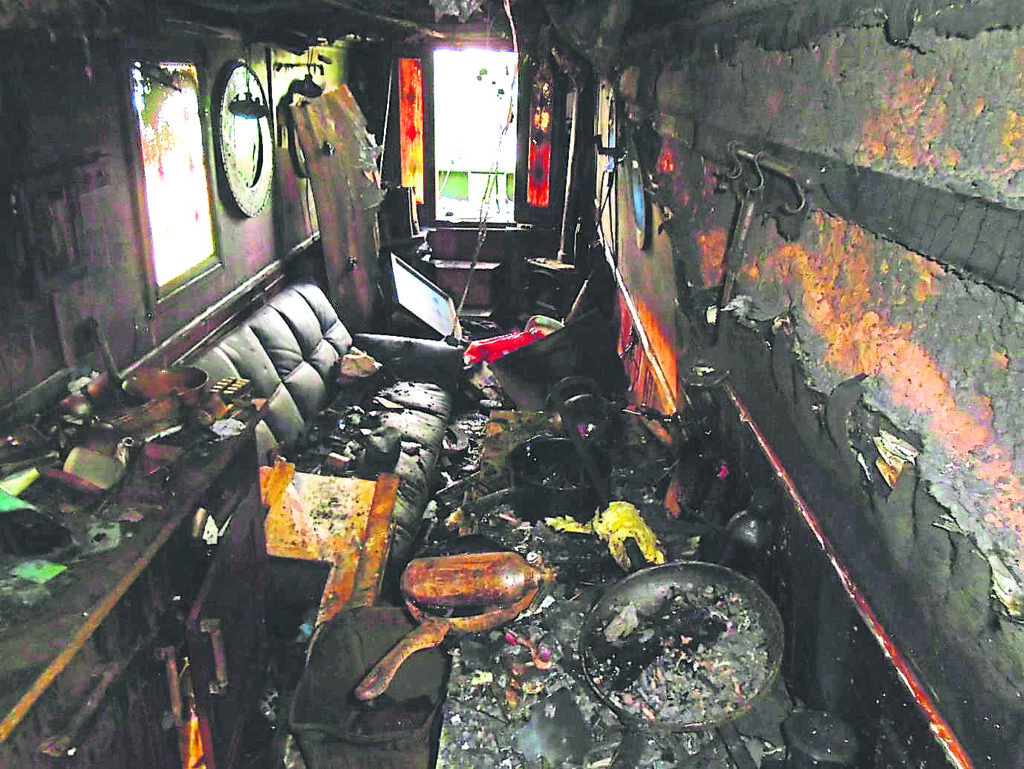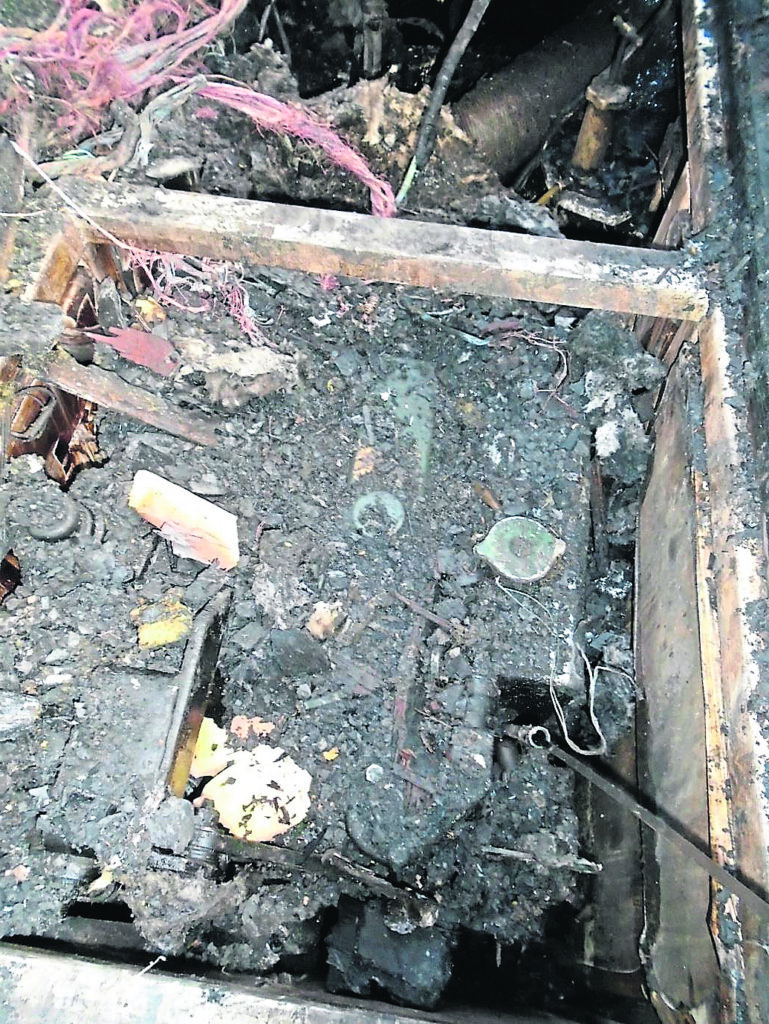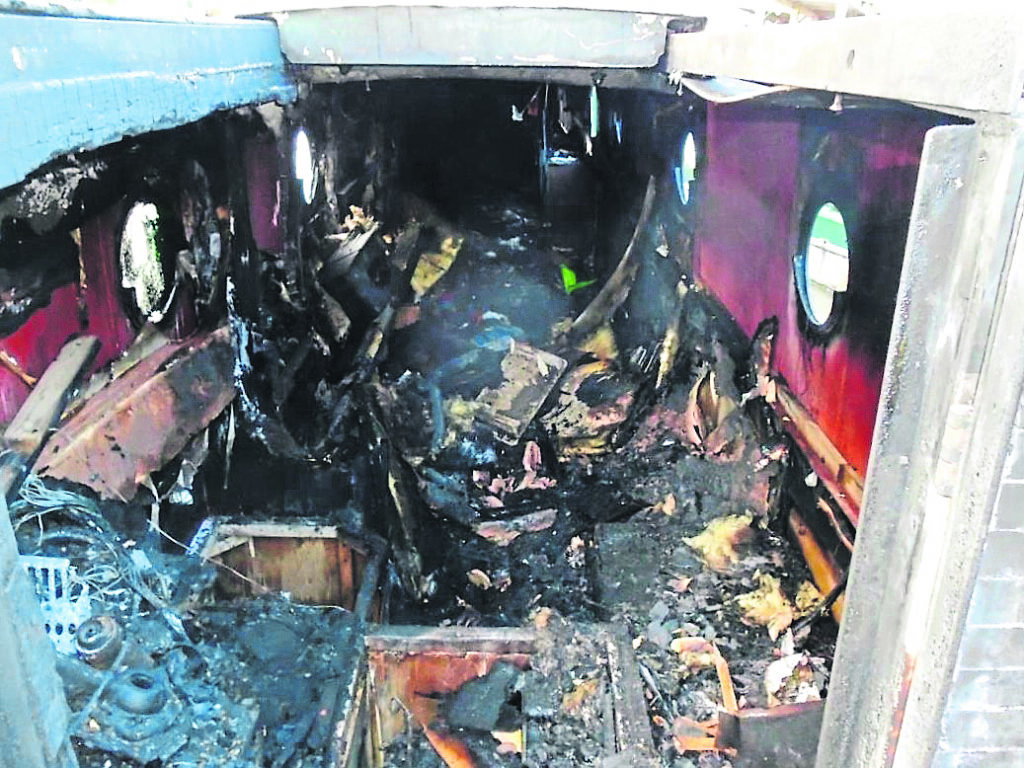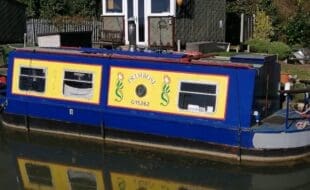Ben Sutcliffe-Davies reports…
MANY owners, during their lifetime on waterways, may be lucky enough to never see a fire on board. However, those who have had the misfortune to be on board either a narrowboat or a GRP motor boat will know that when a fire does break out, it can become life-threatening and extremely terrifying very quickly. So what would you do in a fire?

The first boat fire I ever saw was on the Norfolk Broads when a GRP hire boat went up at Horning Staithe in the late 1970s and within five minutes the fire had ripped through the craft’s accommodation. The gas hoses, after melting, created massive flares of fire, and as quickly as the fire came, it extinguished itself as the vessel sank.
Potential areas of risk
Very few craft have any proper fireproofing throughout. The fabrics and resins used in most production craft are very flammable once ignited. A few years ago I was able to attend a firefighting demonstration on board an RN minesweeper that was built from GRP. They take fire prevention and fire fighting very seriously. Even with the resources on board an RN minesweeper the two things that were made very clear were that fire on board a GRP craft will spread very quickly and the fumes created by GRP and other materials burning will very likely kill you first. For a fire to start, and without sounding like a complete anorak, a combination of three factors is needed. Air, heat and a combustible fuel: take one or two away and the fire will be extinguished.
Engines
Some engines within a steel compartment do give protection to a degree but on many of the GRP motor boats, there is virtually no fireproofing provided. The engine can be one of the most likely areas of ignition with potential heat able to ignite from a faulty fuel line or poor wiring. It’s worth regularly checking all fuel lines are not perished and filter bowls are not weeping; check all electrical connections are in good order.

Battery installations
Ask any surveyor about batteries and I’m sure they all can tell you a few horror stories! One of my worst finds was a battery fitted aft, within the area of the driveshaft, and secured to the exhaust pipe with cable ties! Batteries should be fitted in a secure box with little room to move, terminals should be secure and protected from potential arcing and good venting provided. The more modern gel or sealed batteries are helpful. Connections and poor joints in wiring can cause resistance which will cause heat or sparks.
Heaters
Over the years more and more owners have fitted either solid fuel stoves in very poor locations or have fitted diesel heaters badly, while these generally are very good and reliable. The only fires I have experienced with them are when a crew member inadvertently places a fender over the heater exhaust outlet when mooring. The other potentially dangerous issue that is common is when an owner is selling their vessel, removes the heater and does not suitably blank off the fuel line at the fuel tank. Sometimes owners leave the fuel line within lockers unsealed. Often wires are left exposed in the area where it was fitted.
Gas installation
This is the one area of potential devastation that many owners don’t fully respect. This one subject could take a few pages alone but here are my suggestion highlights. One of the most likely areas of failure is from the gas flexible hoses; many have a manufacturer’s date on them and ideally, it is recommended to replace the hose within five years of the stamped date. Some European companies supply hoses with a label attached showing a ‘replace by’ date. In both cases, it is important to remember that if exposed to UV light the hose can deteriorate quicker.

It’s also important to understand that the gas will deteriorate the rubber pipework. If you have a cooker or a hob please ensure the hose is in good order and on service date. Check the copper pipe run is properly supported and able to vibrate when the engine is used, etc. Get a professionally qualified marine gas engineer to check out the system and get a gas bubble pressure tester fitted; it’s a good way to be able to periodically check the system.
Gas alarms: when undertaking surveys it always amazes me how many craft don’t have a gas alarm fitted. In many of those which do have one fitted, they are frequently not in a position that would give an early warning of any problem.
Bottle storage: I’ve seen many good ways of stowing the gas bottles but one to watch is the integrated bottle moulding that is secured on a shelf with screws through the base and the fastenings are not sealed! Any leak and the gas would be straight into the bilge. Gas storage areas should ideally drain directly overboard. Lastly, don’t store spare gas bottles in lockers or within accommodation!
Upholstery
We all know how at home our sofa has a fire safety tag fitted, indicating fireproof foam and fabrics. Thick, acrid smoke is seen in tests shown on TV. Surprisingly, only craft under the MCA code need fireproof materials. New boat sales may offer upgrades. On other craft, at refit, you could ask the upholsterer to supply suitable foam and materials, there are fireproofing sprays for fabrics that can be applied but most need to be recoated annually. Also watch out for any curtains that have been drawn over or pulled back near the cooker or stove chimney.
Lockers
Some craft seem to have the most amazing lockers that store every bit of equipment that you may need! During a survey, I’ve frequently found an underwriter’s nightmare! Alarming amounts of flammable liquids all stowed together to make the most comprehensive floating bomb possible. With the problems of security, many boat owners will stow the outboard, spare fuel etc and in many cases, the locker is an ideal place to fit the reported diesel heater and often batteries, shore power and battery charger, so in reality it doesn’t take much to start a potentially serious fire.

The plan
After assessing risks, how will we ensure readiness for a fire outbreak? Firstly think about communication, and obviously early evacuation of crew plus methods of early detection of fire by fitting fire alarms in cabins etc.
When I attended the RN demonstration it was made very clear that if the fire couldn’t be brought under control in under two minutes, the evacuation of the craft would almost certainly be necessary. Be aware that the smoke created by a fire will be potentially toxic, acrid and very disorientating.
Selecting suitable fire extinguishers is crucial; don’t just buy cheap ones. Extinguishers in service for five years may not work well. Sometimes the powder may compact and then only a small amount will get discharged when it’s urgent. Different types are available, each with pros and cons. Choose the right one for the likely fire type.
Some fire suppression systems use a clean agent product to put out fires in compartments, like the engine compartment. These systems are less messy and allow visibility and breathing during discharge. However, they require the affected area to be relatively airtight so the gas used is held to build up the required atmospheric concentration so it is important to understand volumes within the craft.
The MCA and RYA websites both list useful information. Where possible try to fit an auto discharge system within the engine compartment, it’s also worth having the version with a manual discharge option fitted. Most autos will discharge at around 80C. But if you can see smoke billowing from the engine compartment it’s worth being able to manually set it off as soon as possible rather than waiting and letting the fire get hold.
A small hole in the front of the engine box will also help for an extra extinguisher. Likewise a means of shutting off the fuel supply by use of a pull wire and not a string will reduce the supply to a fire. This means shutting off the gas at the bottle and not locking the locker with a padlock. Try to find a way to block off any air supplies to the engine compartment.
For every cabin, I recommend a minimum of at least one fire extinguisher and if there is only one exit with no other means of escape, consider a fire blanket stowed in the cabin where it can be found easily. This will give any crew trapped a potential means of being able to shield themselves from flames when escaping.
Galley: if cooking with gas, ensure you know where the appliance gas tap is fitted. If you don’t have a gas alarm, fit a good quality one that has a waterproof sensor; that way it can be fitted within the lower bilge areas. Test it!
It has become very frequent for owners of rechargeable batteries to have the occasional fire; these have been regularly highlighted on the news. I’ve personally seen and attended three fires from rechargeable lithium bike batteries catching fire. So please don’t charge them at night or where they block your escape route! And lastly, evacuation of the craft: have a plan of how to get off the boat at any time of day or night.





